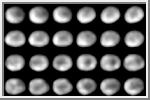|
COMETS EARTH JUPITER KUIPER BELT MARS MERCURY METEORITES NEPTUNE OORT CLOUD PLUTO SATURN SOLAR SYSTEM SPACE SUN URANUS VENUS ORDER PRINTS
PHOTO CATEGORIES SCIENCEVIEWS AMERICAN INDIAN AMPHIBIANS BIRDS BUGS FINE ART FOSSILS THE ISLANDS HISTORICAL PHOTOS MAMMALS OTHER PARKS PLANTS RELIGIOUS REPTILES SCIENCEVIEWS PRINTS
|
Related Document
Download Options
This is a NASA Hubble Space Telescope series of 24 images showing the full 5.34-hour rotation of the 325-mile diameter (525 kilometer) asteroid Vesta. Hubble resolves features as small as 50 miles across, allowing astronomers to map Vesta's geologically diverse terrain. The surface is a complex record of Vesta's four billion-year history. Features include ancient lava flows, and a gigantic impact basin that is so deep, it exposes the asteroid's subsurface, or mantle. This sequence was taken with Hubble's Wide Field Planetary Camera 2 between November 28 and December 1, 1994, when Vesta was at a distance of 156 million miles from Earth. When combined with ground-based data, astronomers will be able to make the first geochemical map of Vesta's surface. |
